Abstract
1. An electrophysiological study was made with the sucrose gap of the compound action potential of the non-myelinated fibres of the garfish olfactory nerve at temperatures between 8 and 22 degrees C. The efflux of 42K with stimulation, and the post-tetanic hyperpolarization following a period of repetitive stimulation, were also studied. 2. At 22 degrees C the compound action potential (at zero conduction distance) reached its peak in about 5 msec and lasted about 12 msec; the conduction velocity was 19.4 cm/sec. The corresponding extrapolated values at 0 degrees C were: time to peak, 16 msec; duration, 37 msec; conduction velocity, 4.2 cm/sec. 3. The rate constant for resting potassium efflux (kr) was 0.0108 min-1 at 22 degrees C and 0.00489 min-1 at 0 degrees C. 4. The extra fractional loss of potassium with stimulation (ks) was 2.02 x 10(-4) impulse-1 at 22 degrees C and 4.41 x 10(-4) impulse-1 at 0 degrees C. 5. Raising the external potassium concentration, or addition of ouabain (1 mM), raised the resting rate of efflux of potassium. 6. The post-tetanic hyperpolarization, which reflects the electrogenic extrusion of sodium ions, indicated a rate constant for active sodium efflux at 22 degrees C of 0.47 min=1. 7. The rate constant was decreased by a 10 degrees C fall in temperature by a factor of 1.73. 8. Increasing the external potassium concentration increased the rate constant, apparently by potassium combining with some site with an equilibrium dissociation constant of 1.2 mMM. 9. The rate constant was decreased slightly in acidic solutions and increased slightly in alkaline solutions. 10. 14C-labelled ouabain was found to bind to the garfish olfactory nerve with an equilibrium dissociation constant of about 0.5 muM. The maximum saturable binding capacity, 22.3 p-mole/mg dry, suggests that there are about 350 sodium pumping sites per square micron membrane.
Full text
PDF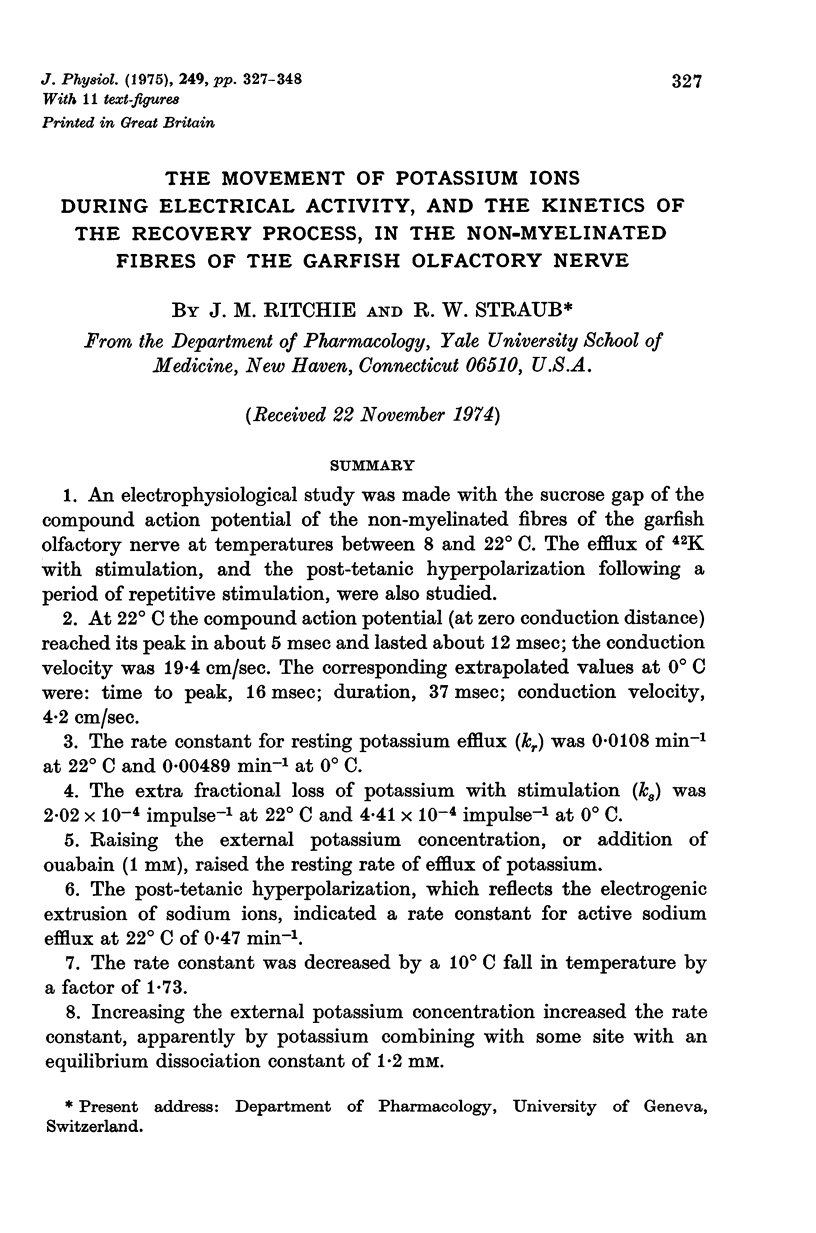
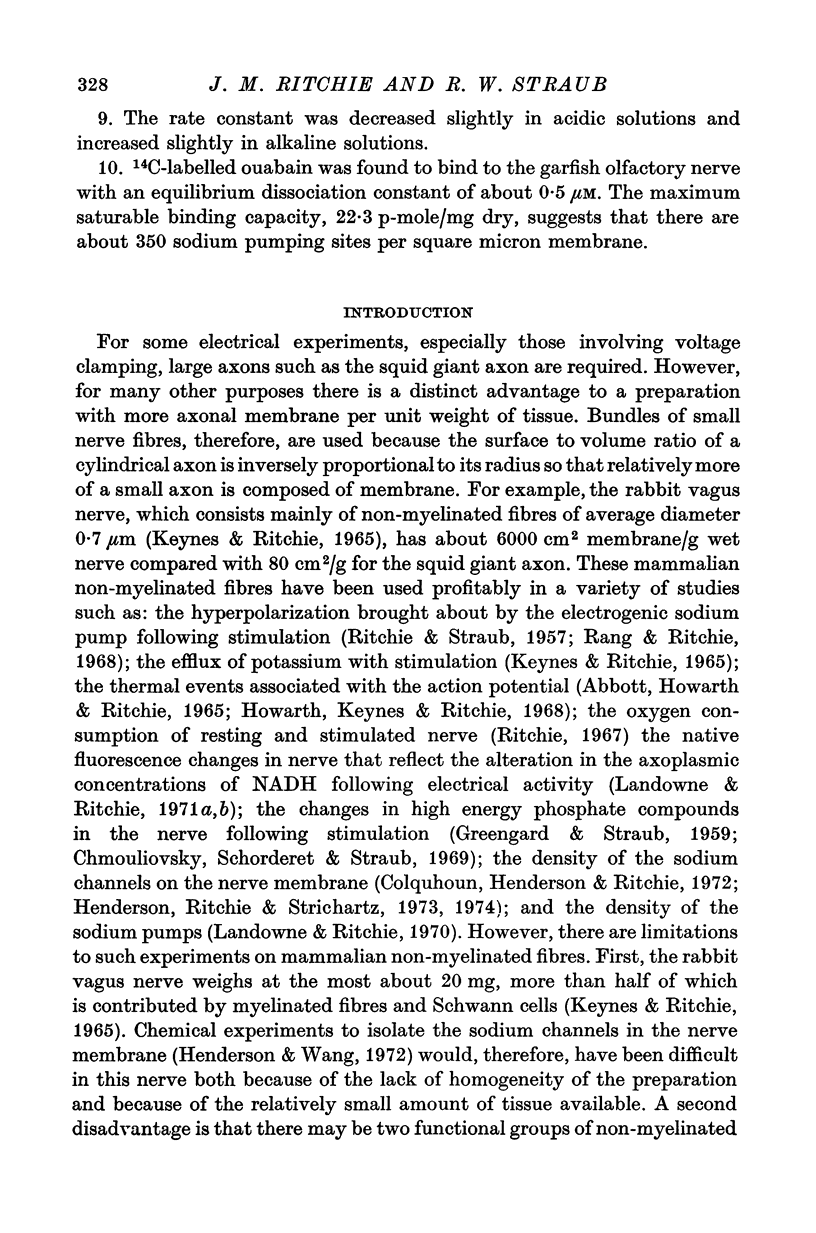
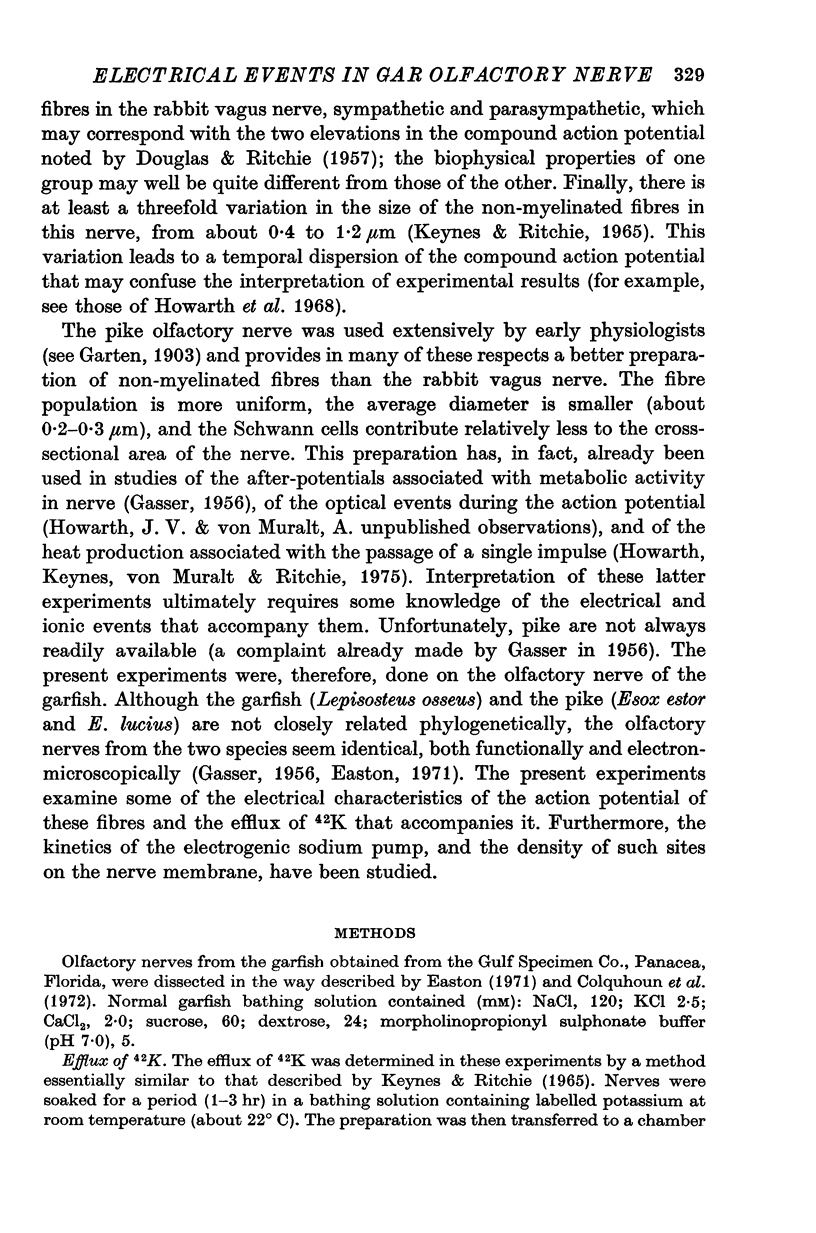
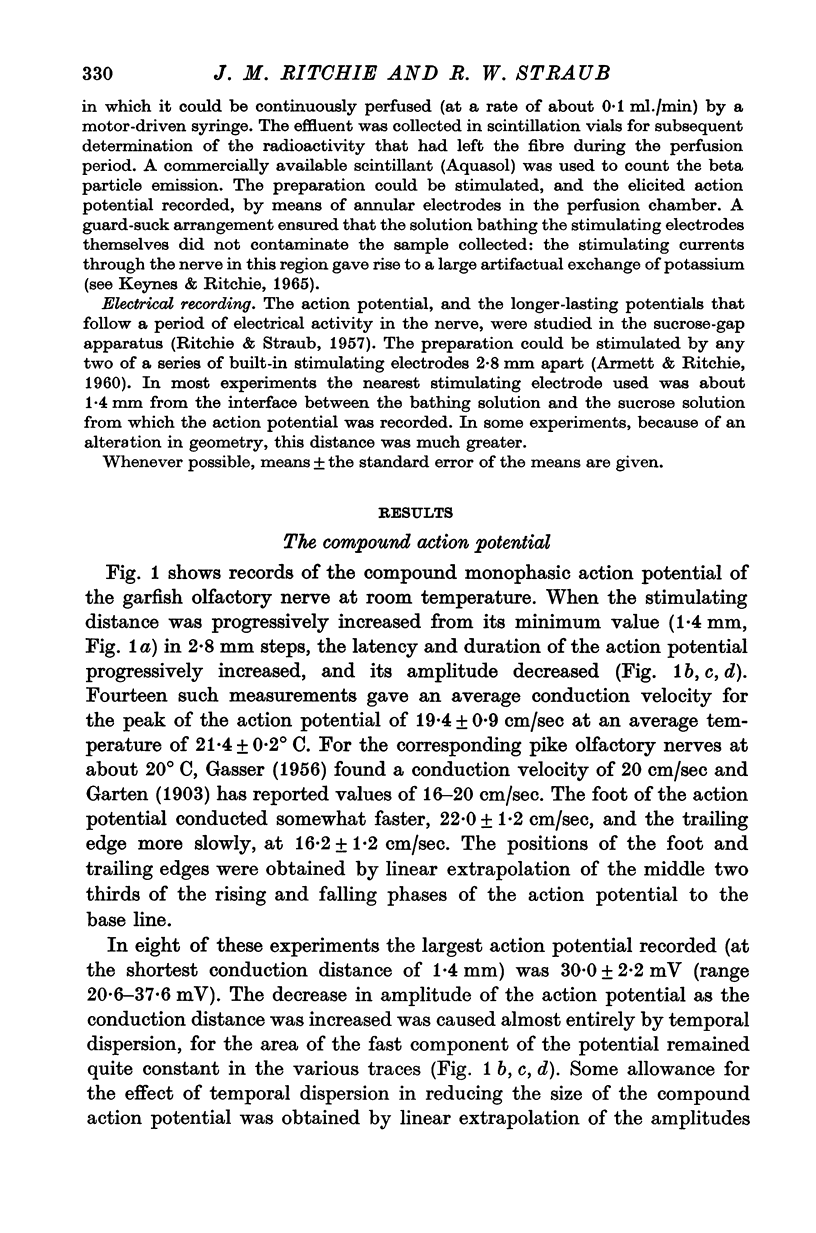
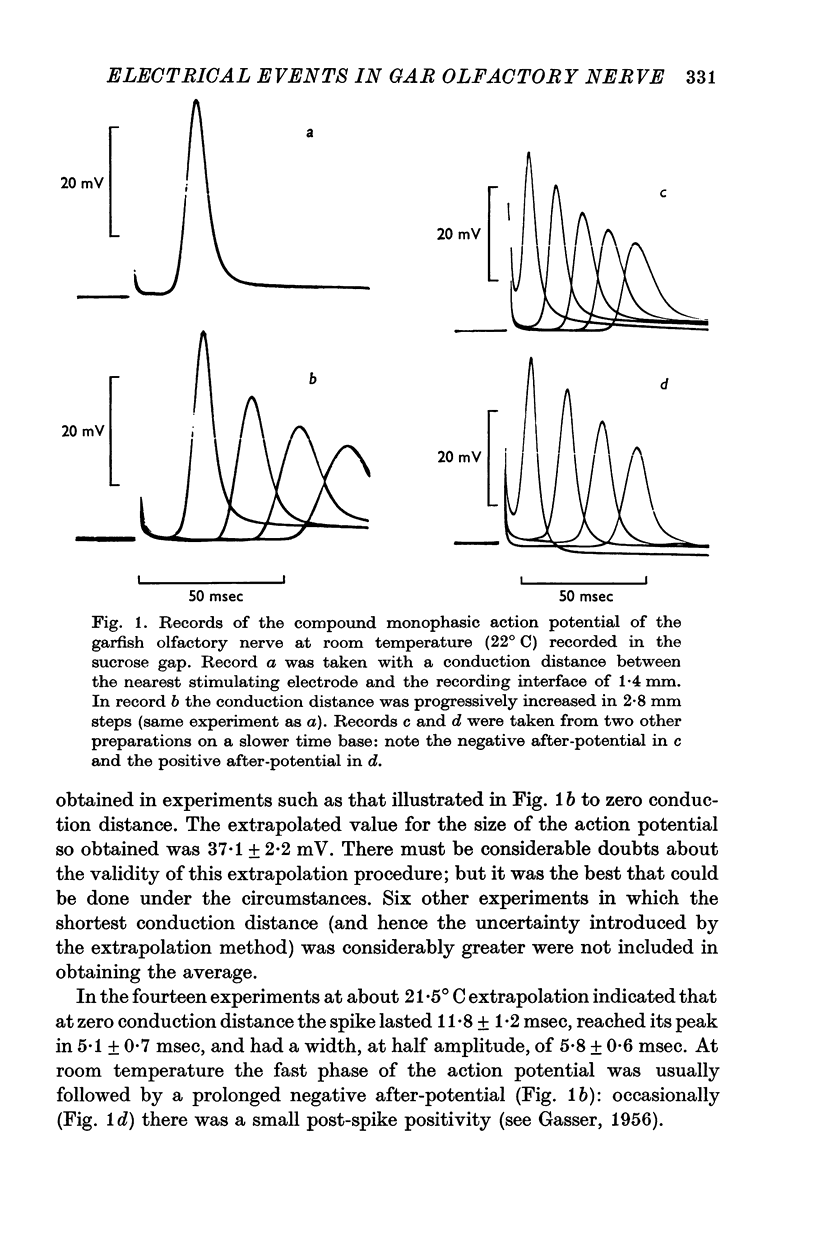
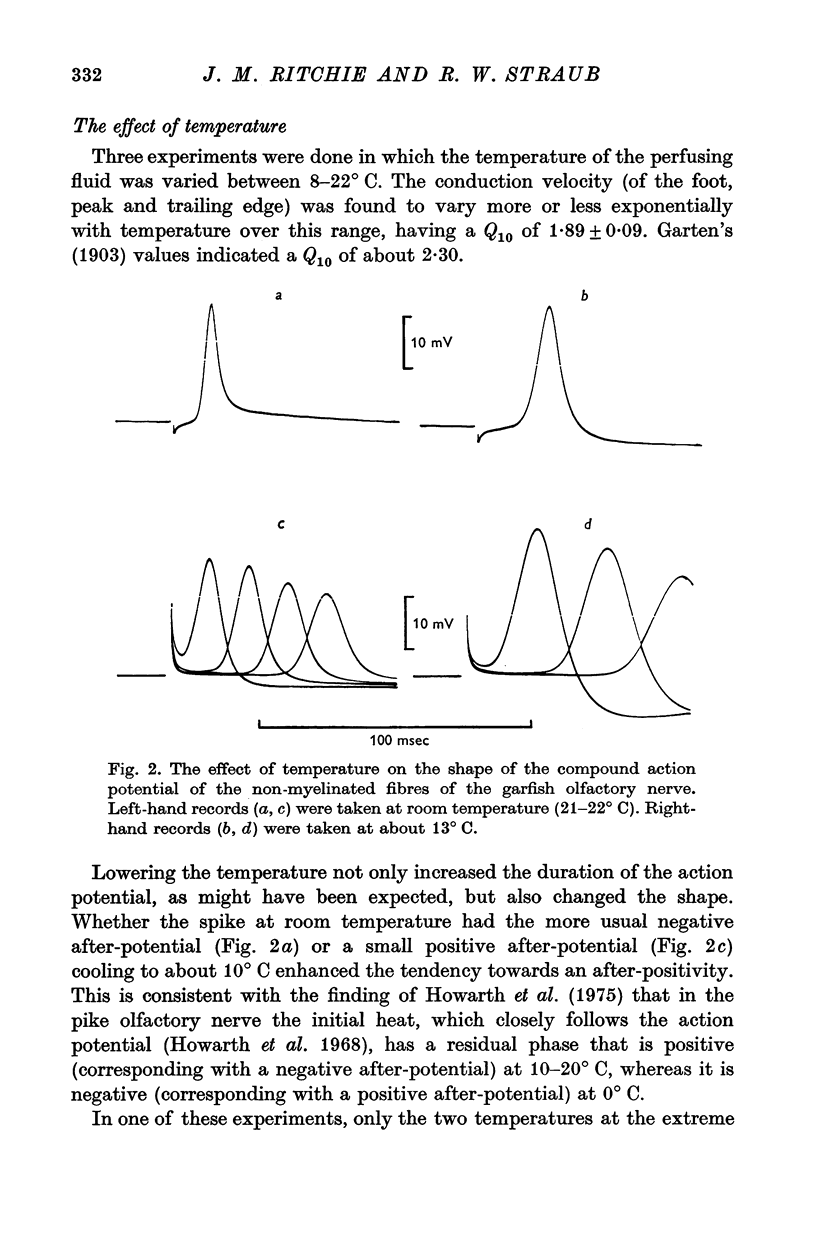
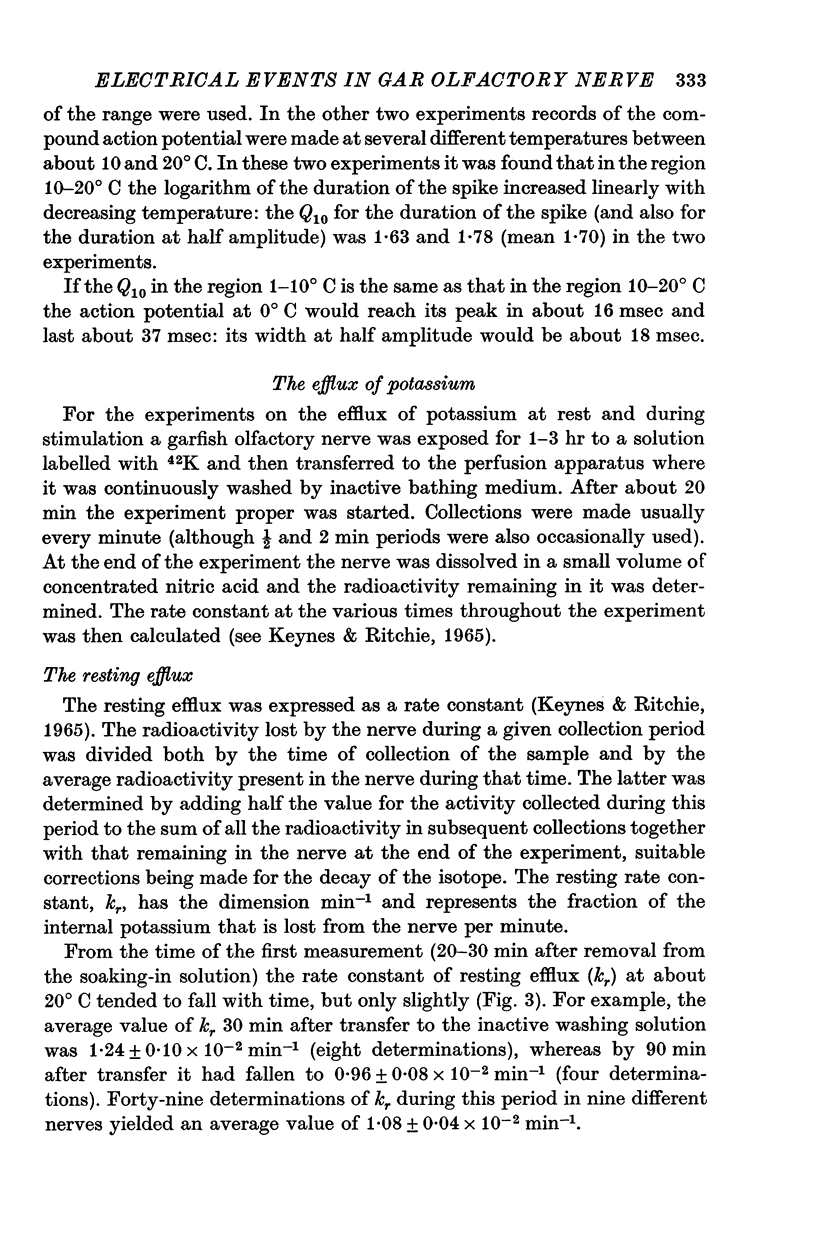
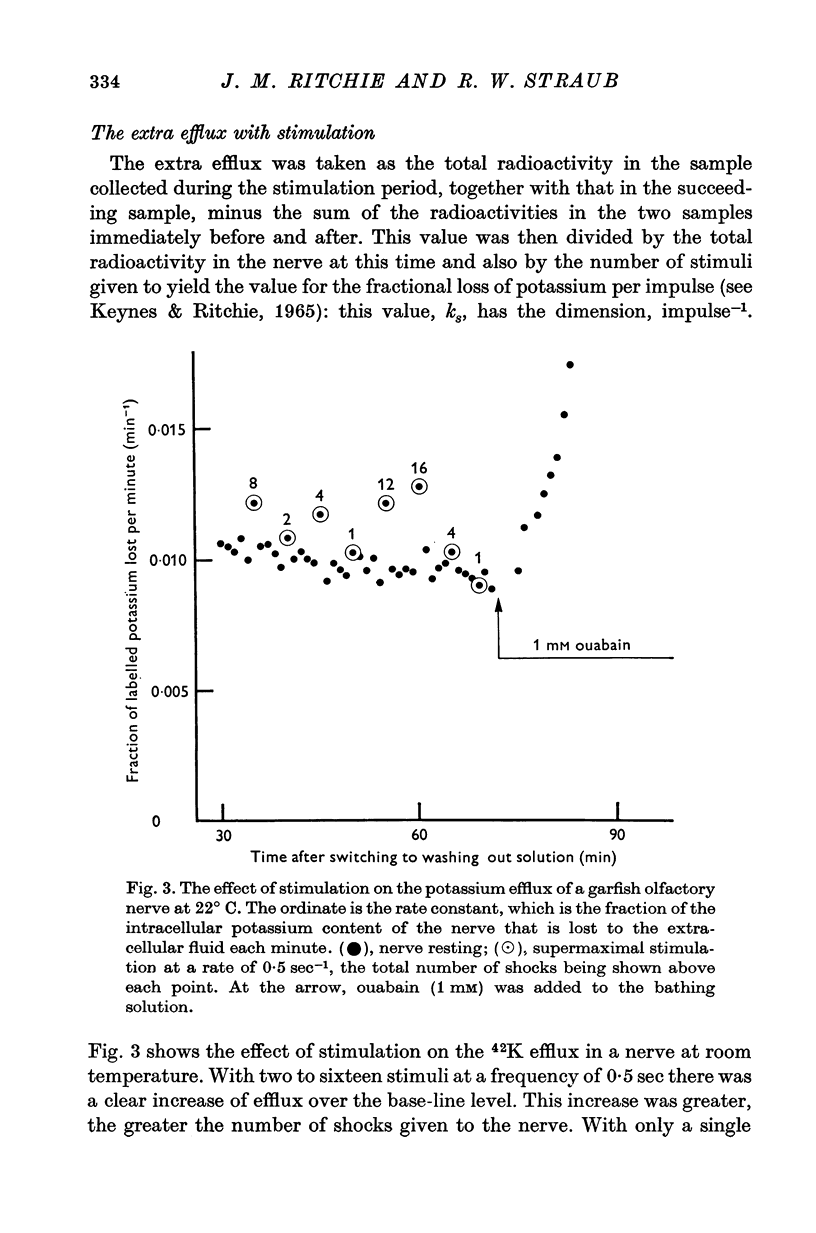
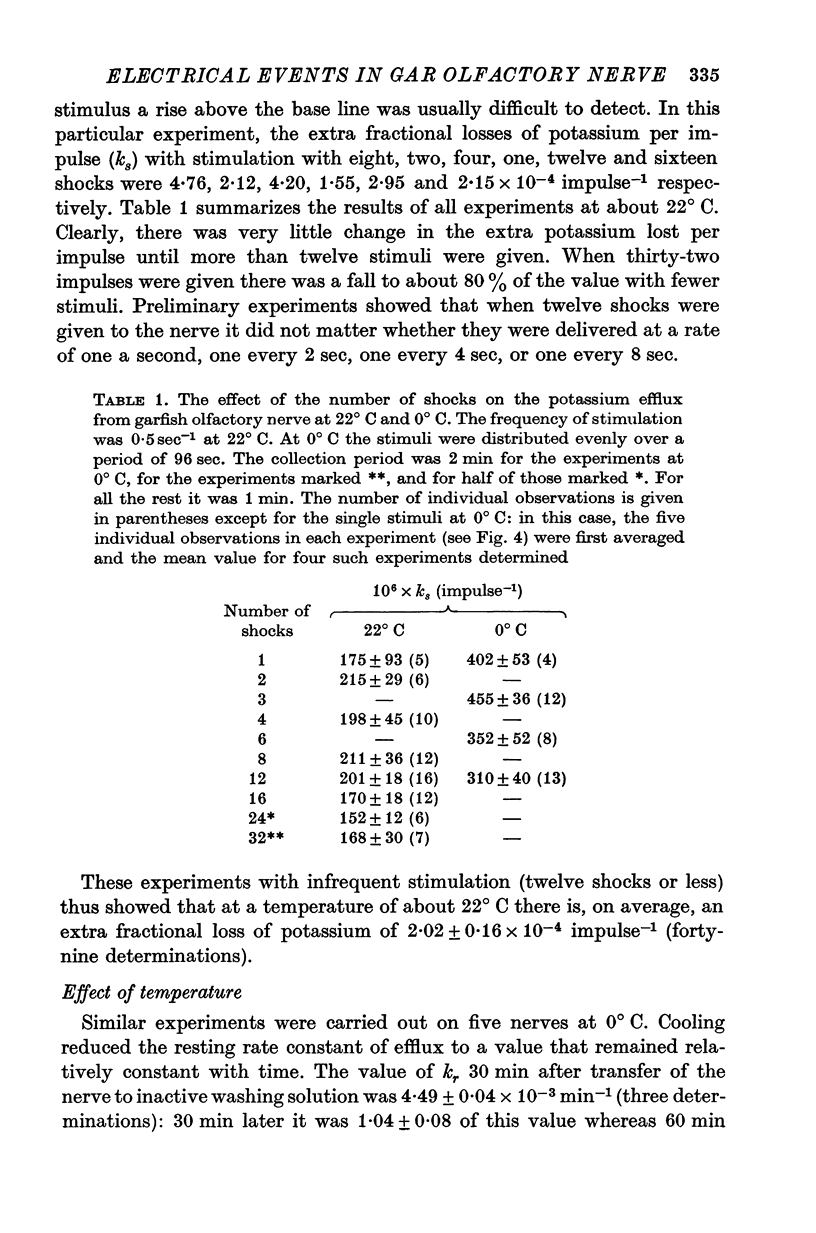
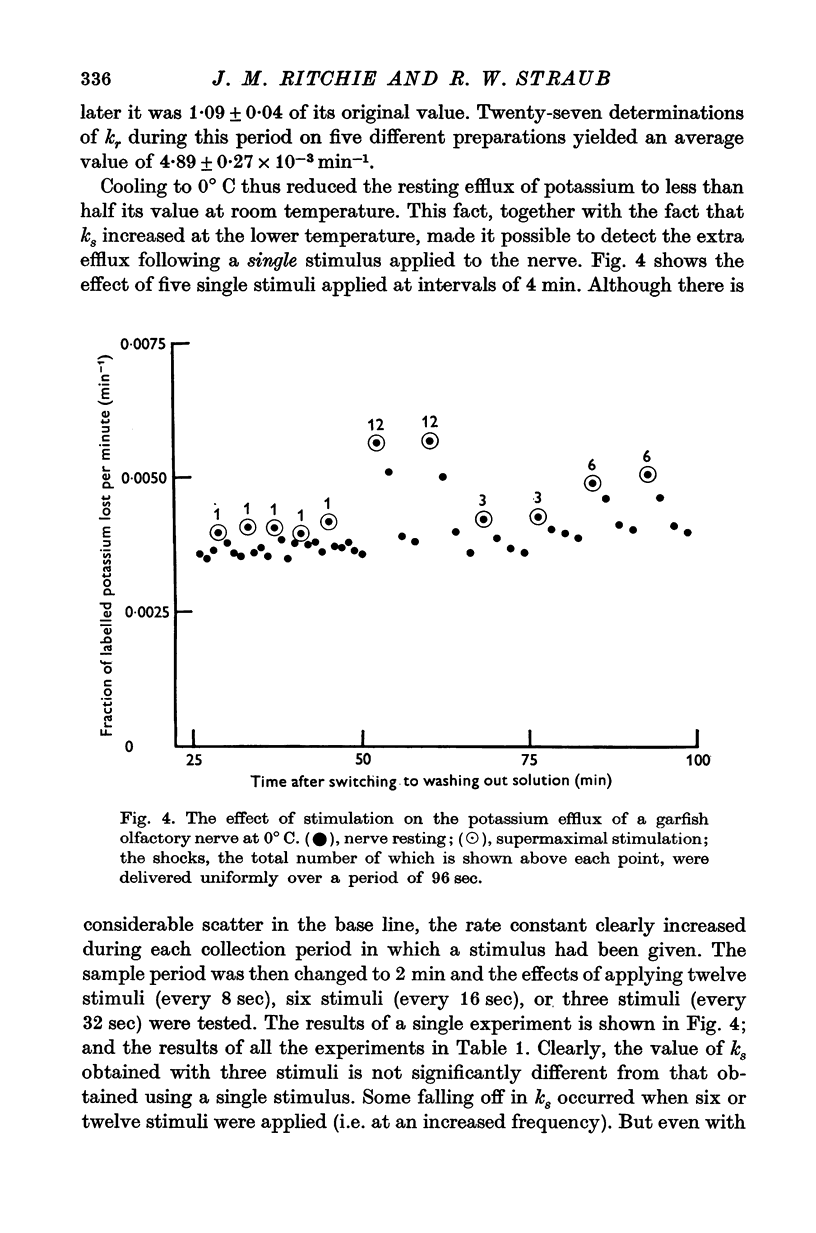
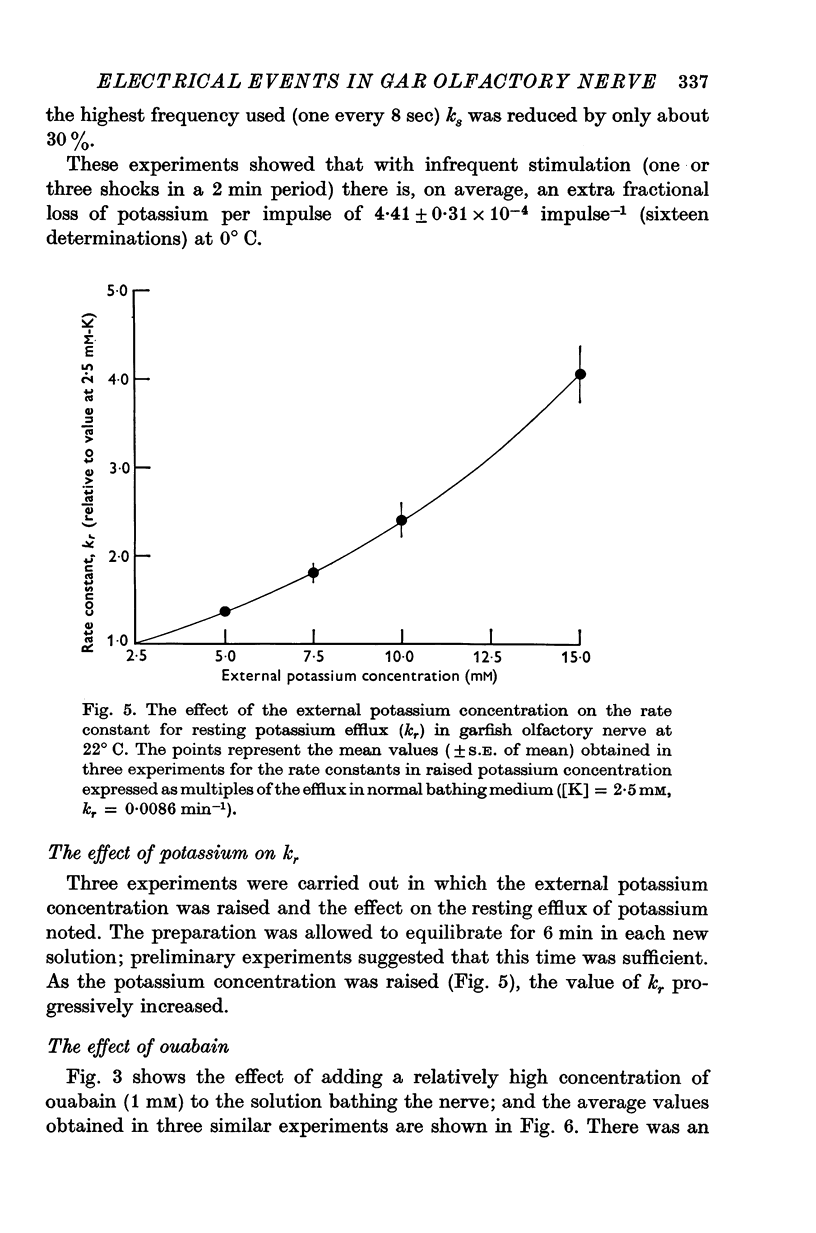
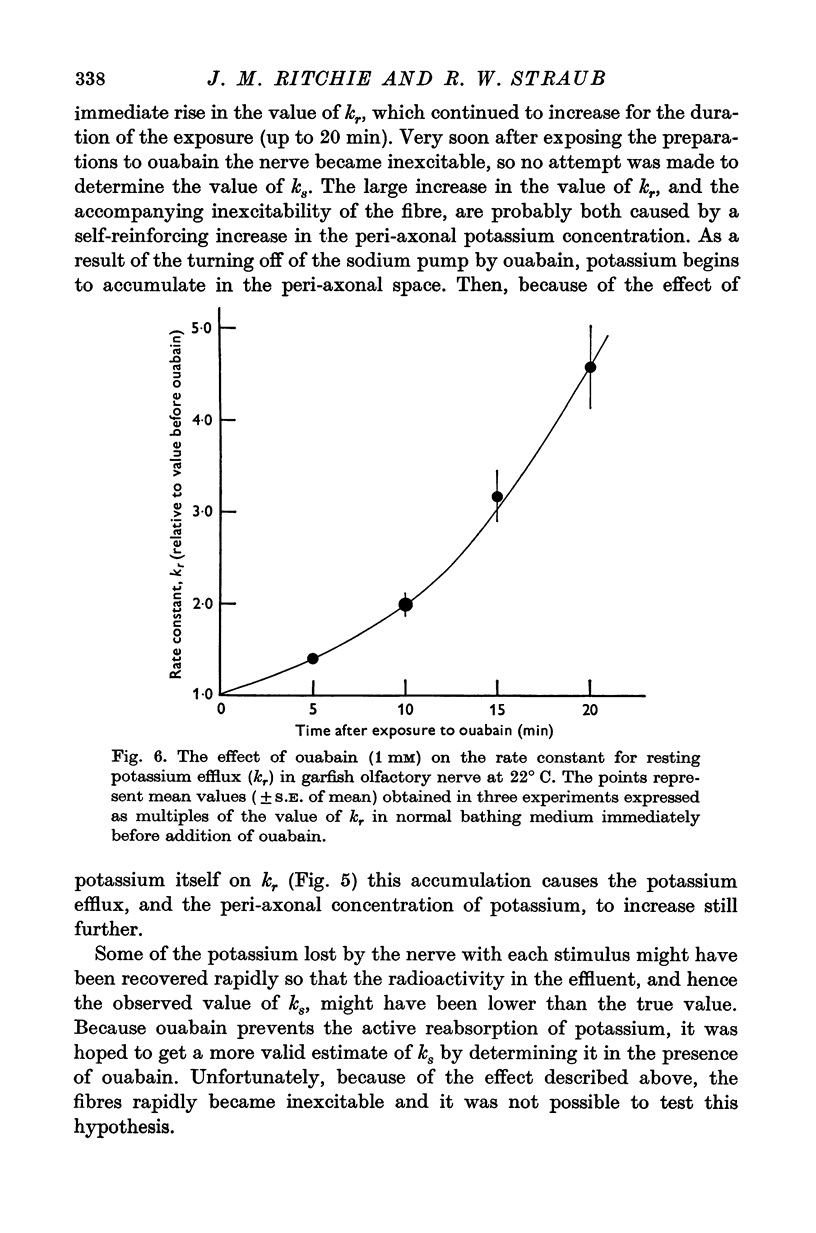
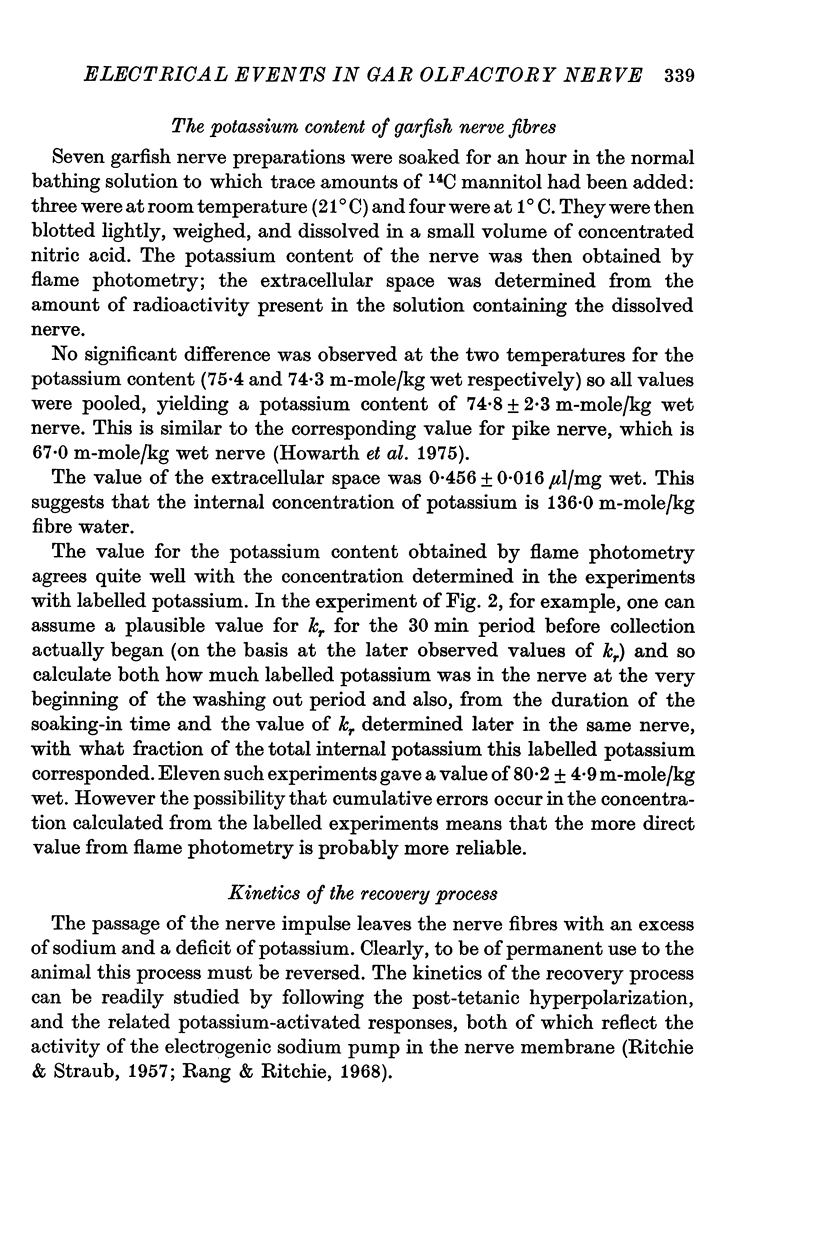
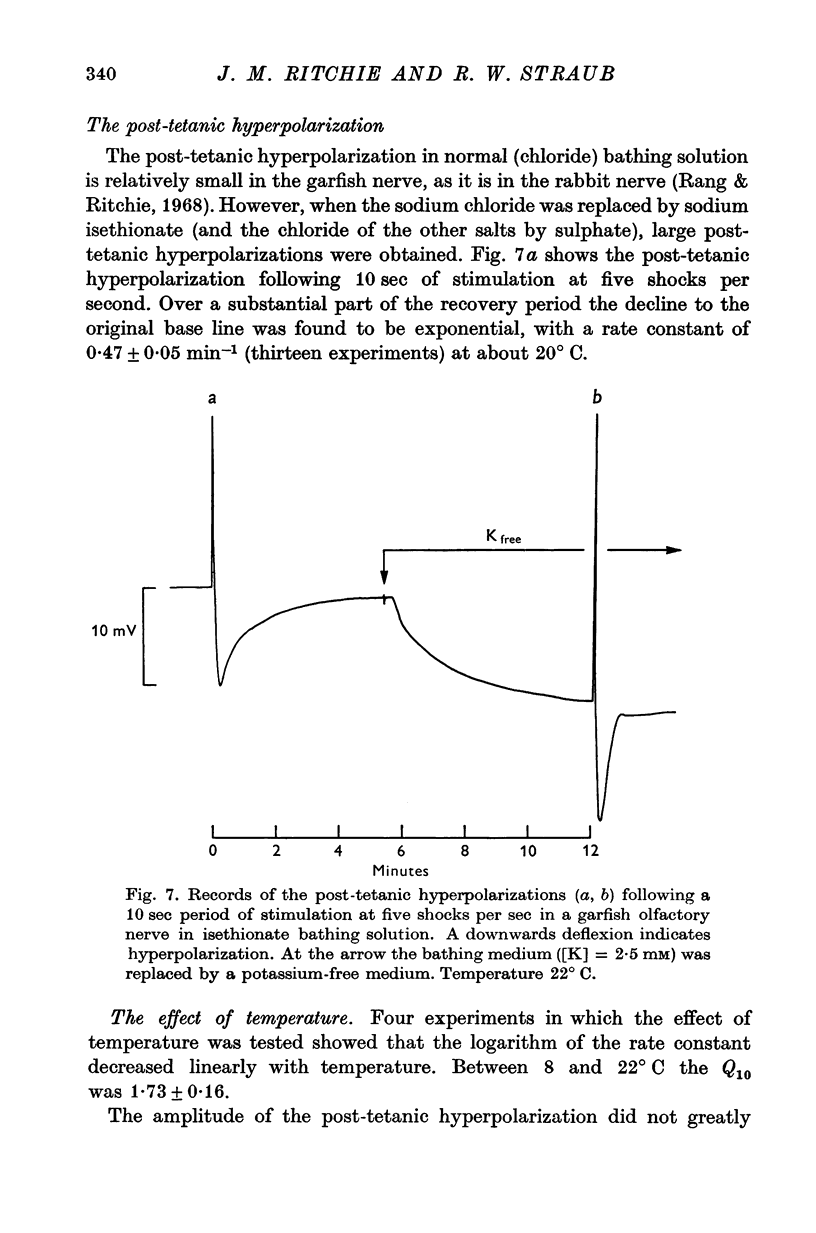
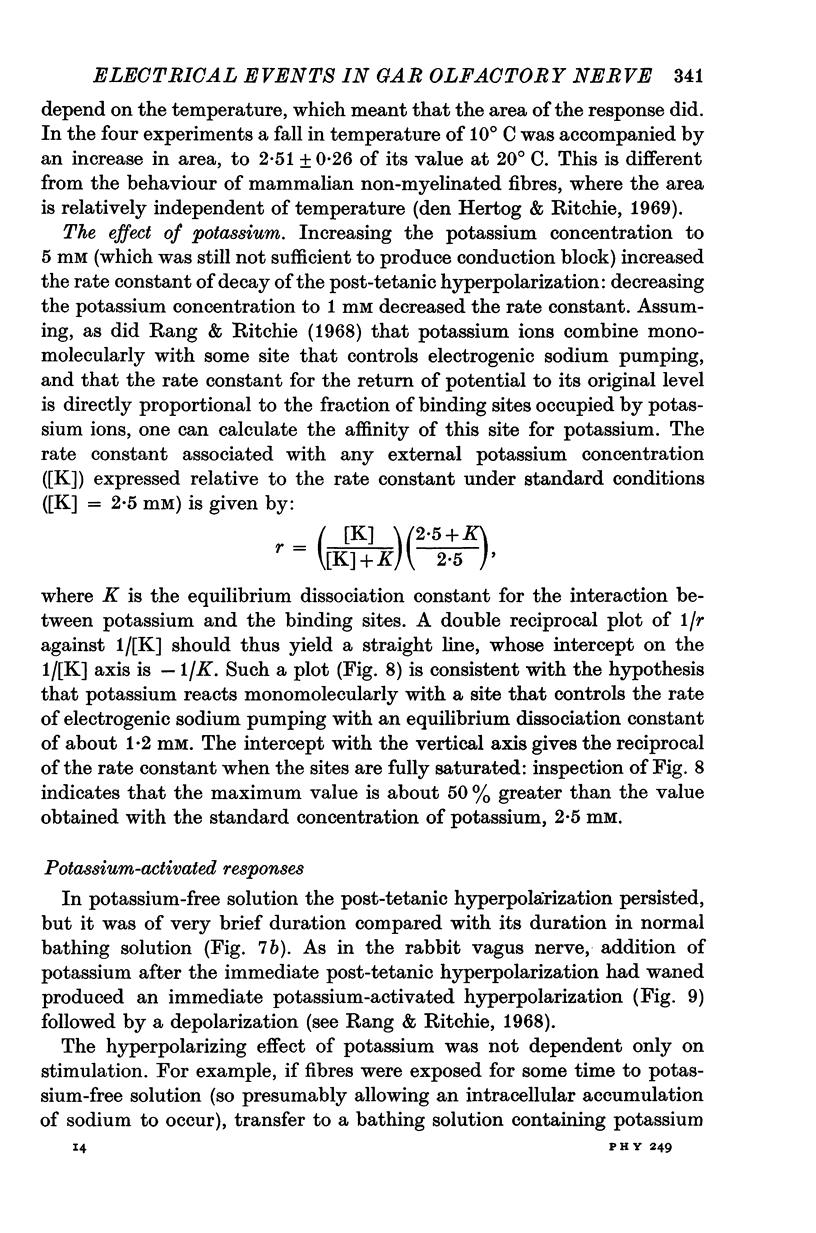
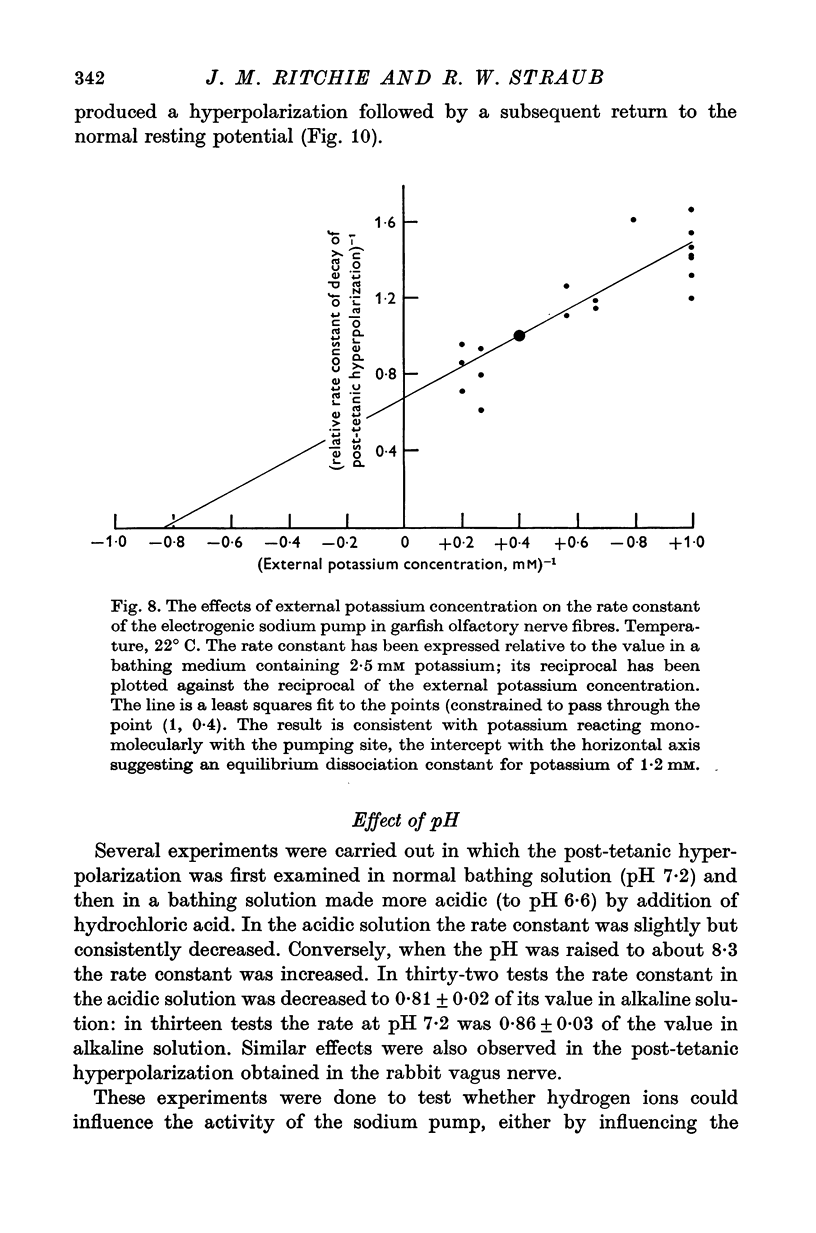
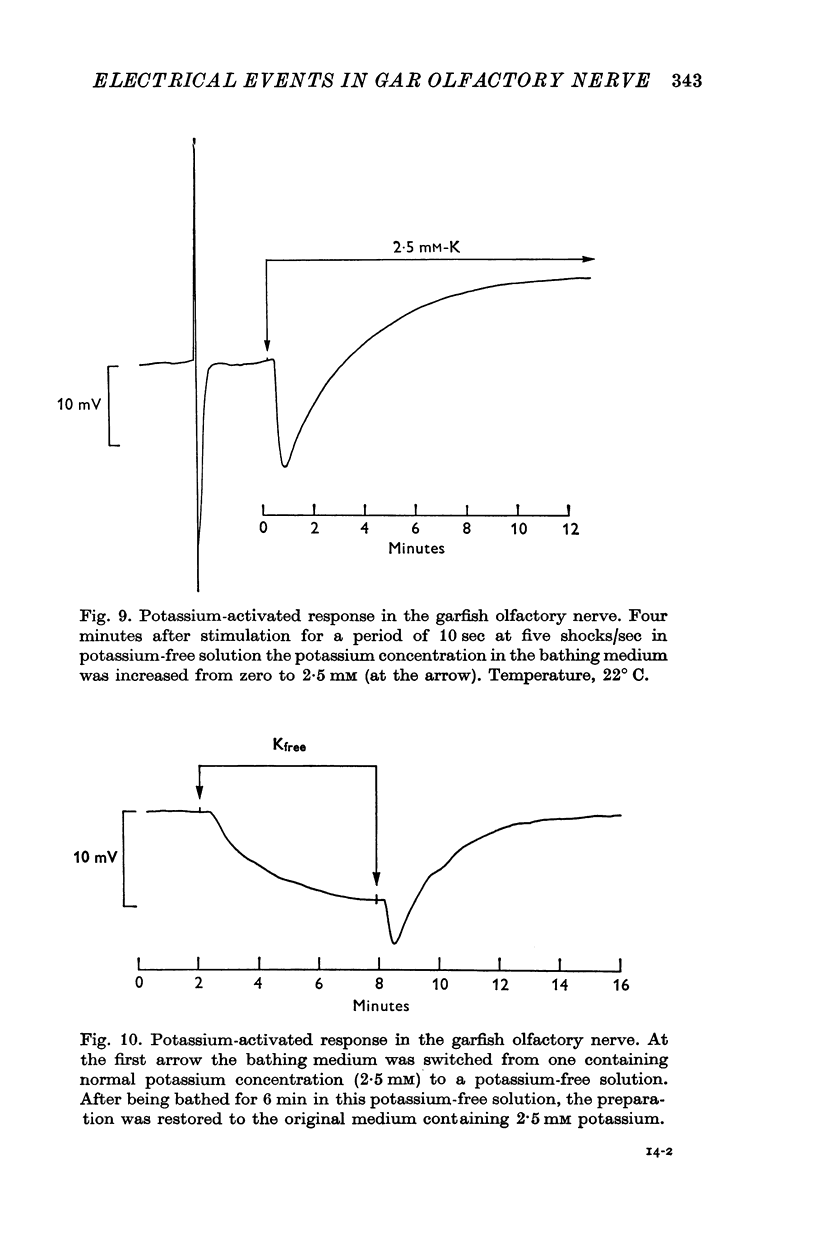
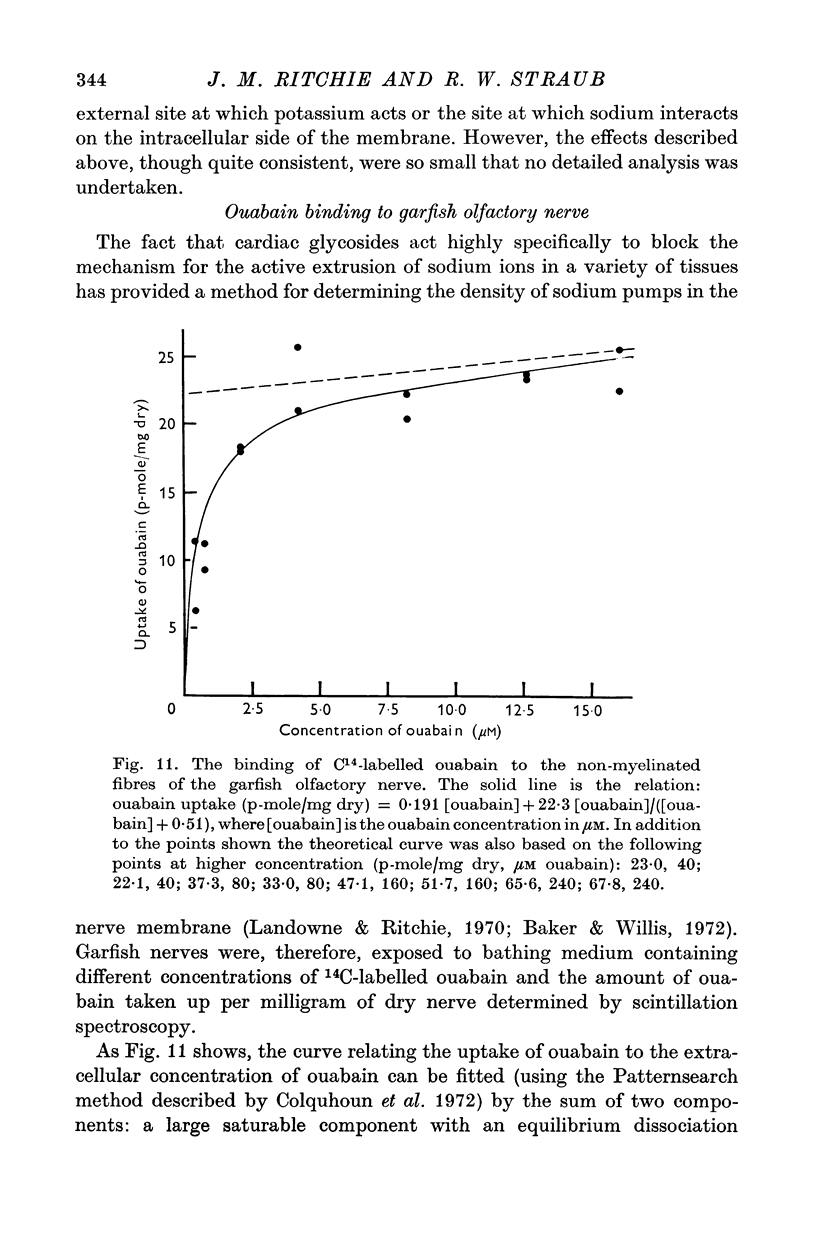
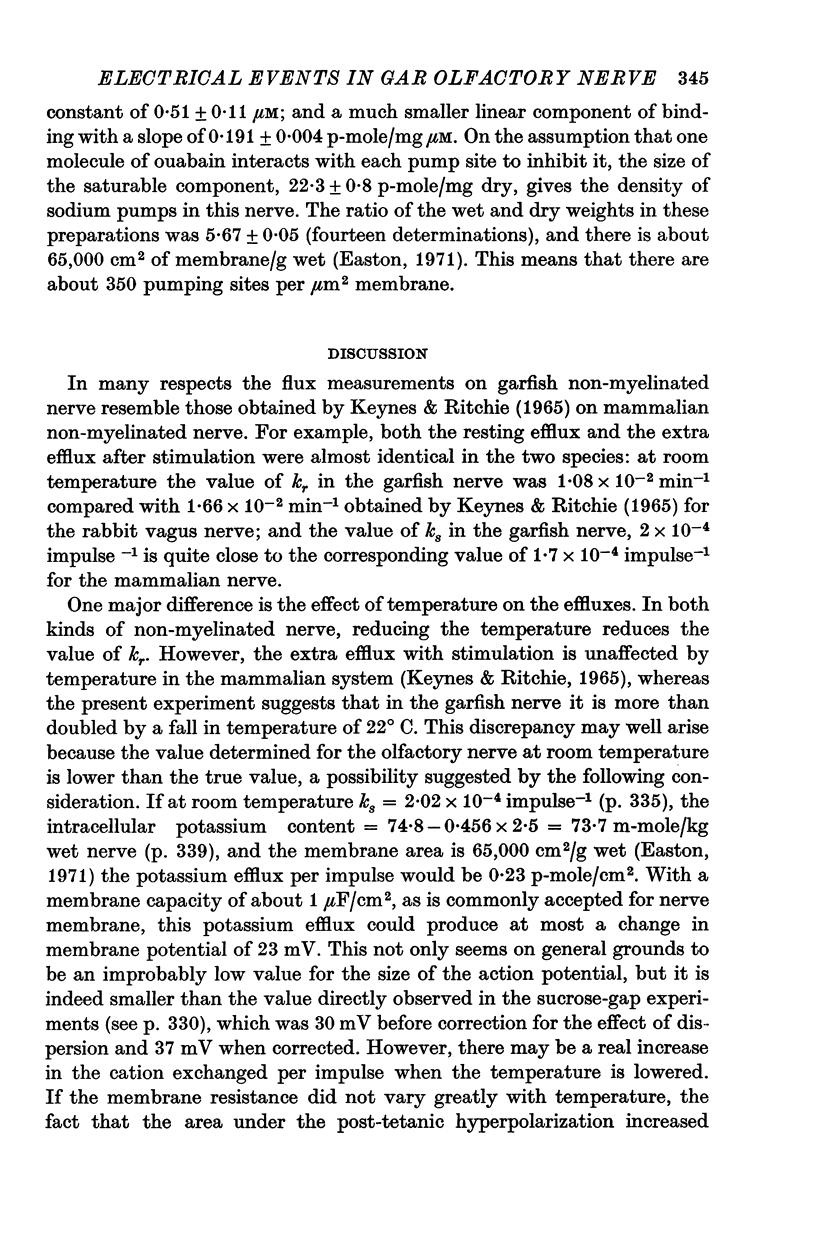
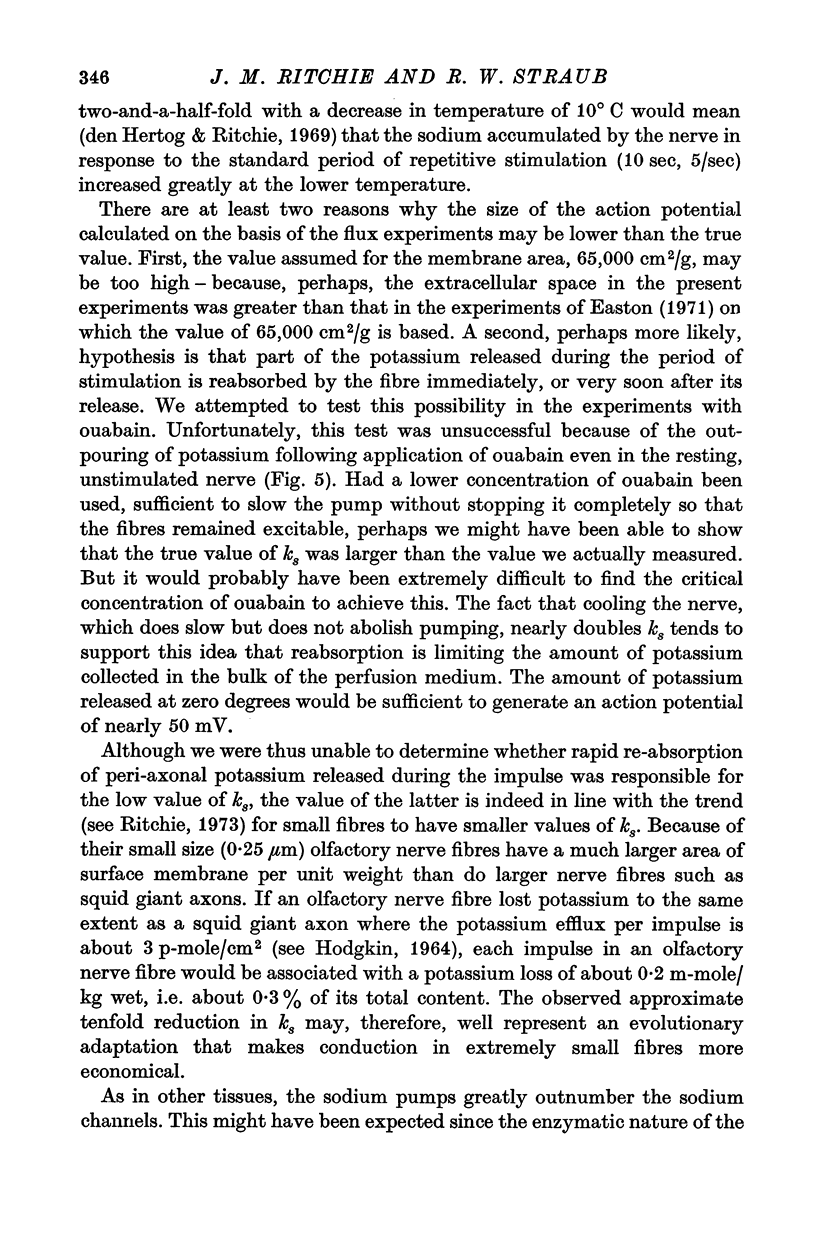
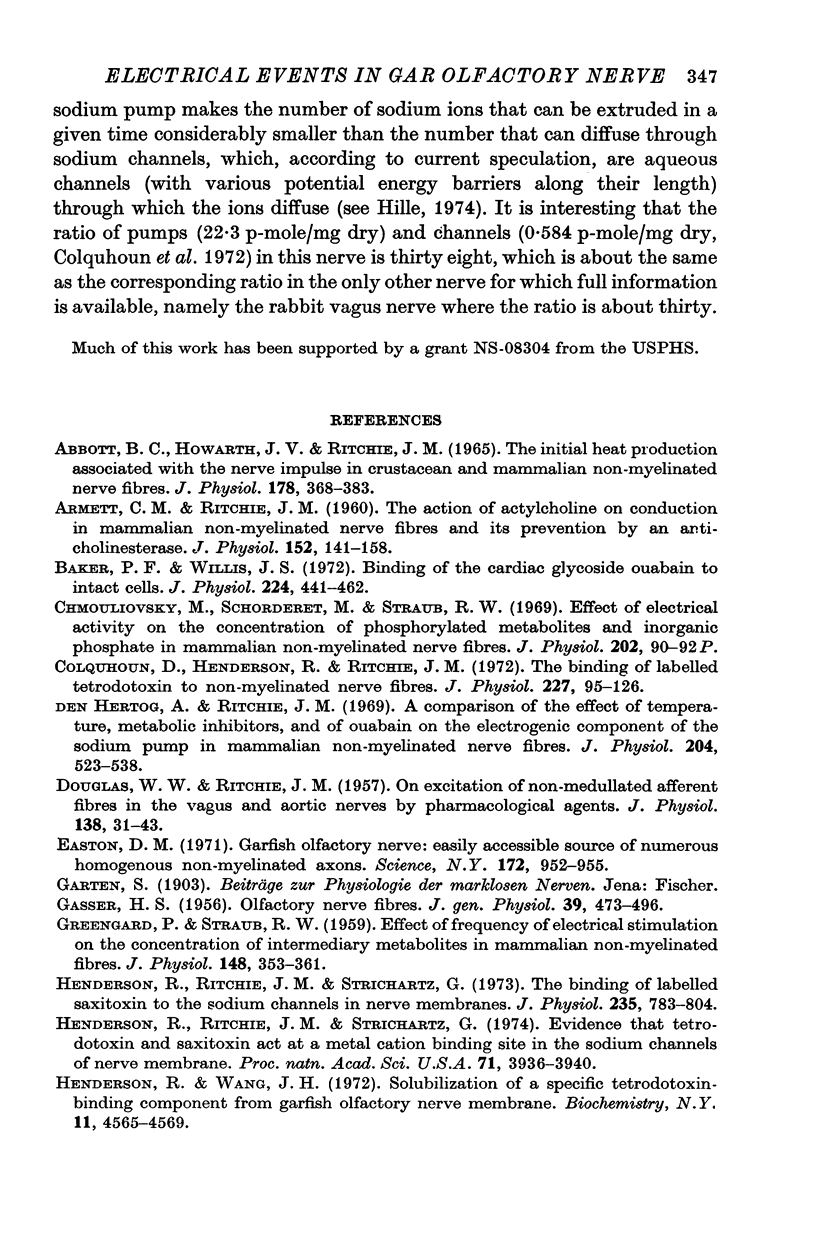
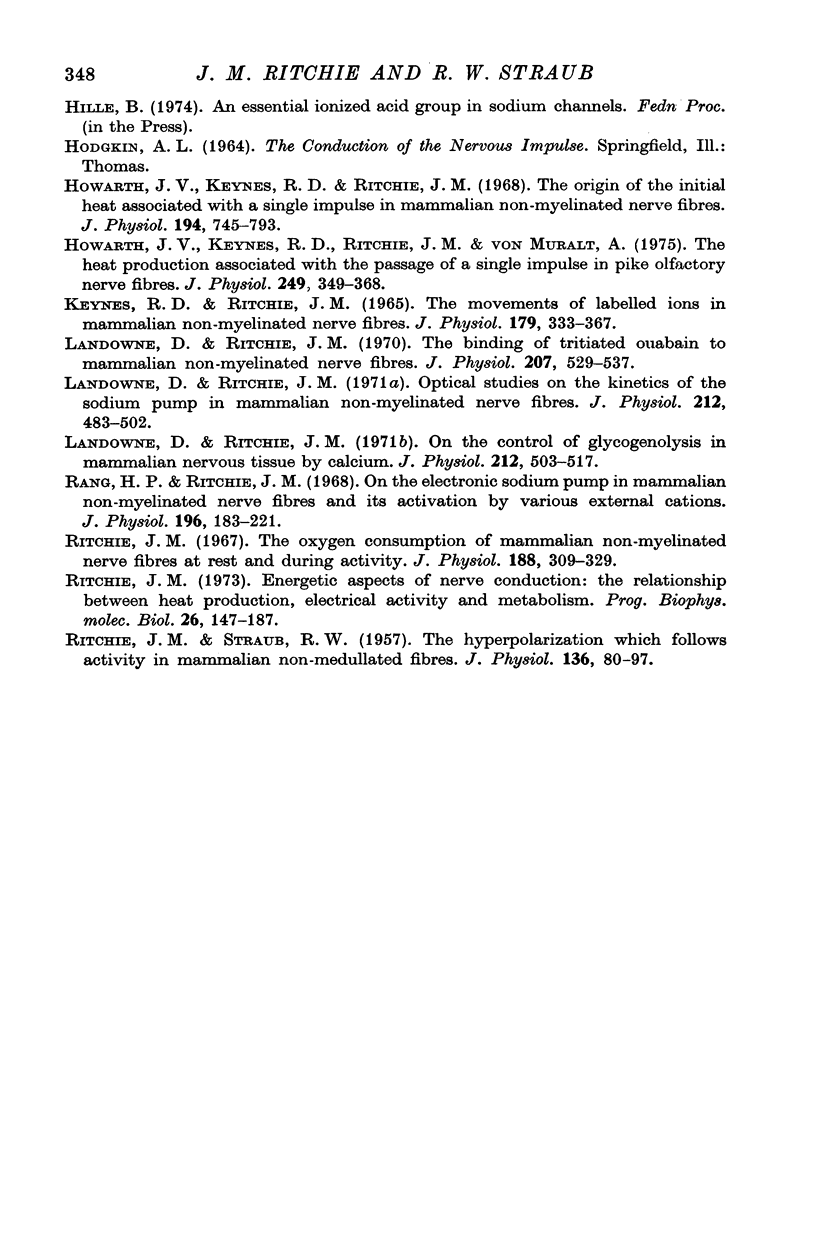
Selected References
These references are in PubMed. This may not be the complete list of references from this article.
- ABBOTT B. C., HOWARTH J. V., RITCHIE J. M. THE INITIAL HEAT PRODUCTION ASSOCIATED WITH THE NERVE IMPULSE IN CRUSTACEAN AND MAMMALIAN NON-MYELINATED NERVE FIBRES. J Physiol. 1965 May;178:368–383. doi: 10.1113/jphysiol.1965.sp007633. [DOI] [PMC free article] [PubMed] [Google Scholar]
- ARMETT C. J., RITCHIE J. M. The action of acetylcholine on conduction in mammalian non-myelinated fibres and its prevention by an anticholinesterase. J Physiol. 1960 Jun;152:141–158. doi: 10.1113/jphysiol.1960.sp006476. [DOI] [PMC free article] [PubMed] [Google Scholar]
- Baker P. F., Willis J. S. Binding of the cardiac glycoside ouabain to intact cells. J Physiol. 1972 Jul;224(2):441–462. doi: 10.1113/jphysiol.1972.sp009904. [DOI] [PMC free article] [PubMed] [Google Scholar]
- Chmouliovsky M., Schorderet M., Straub R. W. Effect of electrical activity on the concentration of phosphorylated metabolites and inorganic phosphate in mammalian non-myelinated nerve fibres. J Physiol. 1969 Jun;202(2):90P–92P. [PubMed] [Google Scholar]
- Colquhoun D., Henderson R., Ritchie J. M. The binding of labelled tetrodotoxin to non-myelinated nerve fibres. J Physiol. 1972 Dec;227(1):95–126. doi: 10.1113/jphysiol.1972.sp010022. [DOI] [PMC free article] [PubMed] [Google Scholar]
- DOUGLAS W. W., RITCHIE J. M. On excitation of non-medullated afferent fibres in the vagus and aortic nerves by pharmacological agents. J Physiol. 1957 Aug 29;138(1):31–43. doi: 10.1113/jphysiol.1957.sp005836. [DOI] [PMC free article] [PubMed] [Google Scholar]
- Easton D. M. Garfish olfactory nerve: easily accessible source of numerous long, homogeneous, nonmyelinated axons. Science. 1971 May 28;172(3986):952–955. doi: 10.1126/science.172.3986.952. [DOI] [PubMed] [Google Scholar]
- GASSER H. S. Olfactory nerve fibers. J Gen Physiol. 1956 Mar 20;39(4):473–496. doi: 10.1085/jgp.39.4.473. [DOI] [PMC free article] [PubMed] [Google Scholar]
- GREENGARD P., STRAUB R. W. Effect of frequency of electrical stimulation on the concentration of intermediary metabolites in mammalian non-myelinated fibres. J Physiol. 1959 Oct;148:353–361. doi: 10.1113/jphysiol.1959.sp006292. [DOI] [PMC free article] [PubMed] [Google Scholar]
- Henderson R., Ritchie J. M., Strichartz G. R. Evidence that tetrodotoxin and saxitoxin act at a metal cation binding site in the sodium channels of nerve membrane. Proc Natl Acad Sci U S A. 1974 Oct;71(10):3936–3940. doi: 10.1073/pnas.71.10.3936. [DOI] [PMC free article] [PubMed] [Google Scholar]
- Henderson R., Ritchie J. M., Strichartz G. R. The binding of labelled saxitoxin to the sodium channels in nerve membranes. J Physiol. 1973 Dec;235(3):783–804. doi: 10.1113/jphysiol.1973.sp010417. [DOI] [PMC free article] [PubMed] [Google Scholar]
- Henderson R., Wang J. H. Solubilization of a specific tetrodotoxin-binding component from garfish olfactory nerve membrane. Biochemistry. 1972 Nov 21;11(24):4565–4569. doi: 10.1021/bi00774a022. [DOI] [PubMed] [Google Scholar]
- Howarth J. V., Keynes R. D., Ritchie J. M. The origin of the initial heat associated with a single impulse in mammalian non-myelinated nerve fibres. J Physiol. 1968 Feb;194(3):745–793. doi: 10.1113/jphysiol.1968.sp008434. [DOI] [PMC free article] [PubMed] [Google Scholar]
- Howarth J. V., Keynes R. D., Ritchie J. M., von Muralt A. The heat production associated with the passage of a single impulse in pike olfactory nerve fibres. J Physiol. 1975 Jul;249(2):349–368. doi: 10.1113/jphysiol.1975.sp011019. [DOI] [PMC free article] [PubMed] [Google Scholar]
- Keynes R. D., Ritchie J. M. The movements of labelled ions in mammalian non-myelinated nerve fibres. J Physiol. 1965 Jul;179(2):333–367. doi: 10.1113/jphysiol.1965.sp007666. [DOI] [PMC free article] [PubMed] [Google Scholar]
- Landowne D., Ritchie J. M. On the control of glycogenolysis in mammalian nervous tissue by calcium. J Physiol. 1971 Jan;212(2):503–517. doi: 10.1113/jphysiol.1971.sp009338. [DOI] [PMC free article] [PubMed] [Google Scholar]
- Landowne D., Ritchie J. M. Optical studies on the kinetics of the sodium pump in mammalian non-myelinated nerve fibres. J Physiol. 1971 Jan;212(2):483–502. doi: 10.1113/jphysiol.1971.sp009337. [DOI] [PMC free article] [PubMed] [Google Scholar]
- Landowne D., Ritchie J. M. The binding of tritiated ouabain to mammalian non-myelinated nerve fibres. J Physiol. 1970 Apr;207(2):529–537. doi: 10.1113/jphysiol.1970.sp009077. [DOI] [PMC free article] [PubMed] [Google Scholar]
- RITCHIE J. M., STRAUB R. W. The hyperpolarization which follows activity in mammalian non-medullated fibres. J Physiol. 1957 Apr 3;136(1):80–97. doi: 10.1113/jphysiol.1957.sp005744. [DOI] [PMC free article] [PubMed] [Google Scholar]
- Rang H. P., Ritchie J. M. On the electrogenic sodium pump in mammalian non-myelinated nerve fibres and its activation by various external cations. J Physiol. 1968 May;196(1):183–221. doi: 10.1113/jphysiol.1968.sp008502. [DOI] [PMC free article] [PubMed] [Google Scholar]
- Ritchie J. M. Energetic aspects of nerve conduction: the relationships between heat production, electrical activity and metabolism. Prog Biophys Mol Biol. 1973;26:147–187. doi: 10.1016/0079-6107(73)90019-9. [DOI] [PubMed] [Google Scholar]
- Ritchie J. M. The oxygen consumption of mammalian non-myelinated nerve fibres at rest and during activity. J Physiol. 1967 Feb;188(3):309–329. doi: 10.1113/jphysiol.1967.sp008141. [DOI] [PMC free article] [PubMed] [Google Scholar]
- den Hertog A., Ritchie J. M. A comparison of the effect of temperature, metabolic inhibitors and of ouabain on the electrogenic componen of the sodium pump in mammalian non-myelinated nerve fibres. J Physiol. 1969 Oct;204(3):523–538. doi: 10.1113/jphysiol.1969.sp008929. [DOI] [PMC free article] [PubMed] [Google Scholar]


